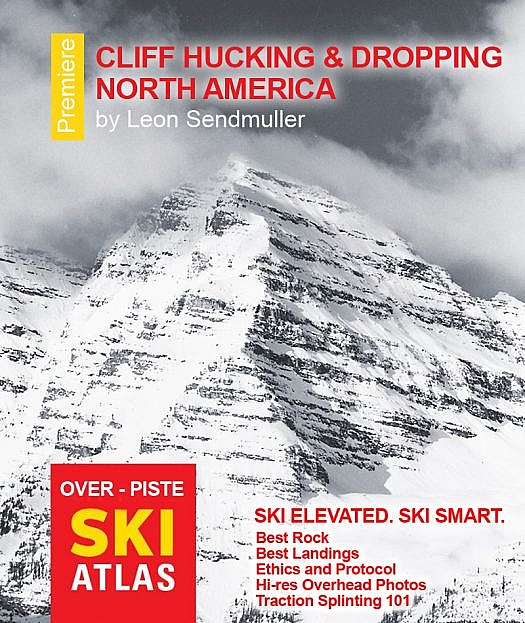This post sponsored by our publishing partner Triple Freak Backcountry. I’d share their URL but I can’t find it, word is they moved their website to the dark web due to low prices. Comments welcome.
I have a full review coming for this amazing book after I test a few routes, but check my first-look below. Author Sendmuller is one of our most prolific guest bloggers, so I don’t think I’ll be disappointed. Over-Piste publishing produced my last guidebook, and a slew of others, check them out!
This is the perfect compliment to my “Uphill Skiing & Mundane Tours” book that Over-Piste published last year. It’s a graduation of sorts. When you’ve skied up all the resorts in Colorado and find yourself dreading the desiccated hamburgers in the base lodge, time to fly off the fourteeners!
Sendmuller’s book details 45 cliffs, with all necessary beta. He tells you how loose the rock is (especially important on Colorado peaks), and describes the starting zone. During nine years of meticulous field work, he measured the angle of each landing with a pro-grade inclinometer. One of his ground-breaking details is he provides a chart of DIN binding settings alogorythmically derived from length of drop, weight of skier, flex rating of boots, air density — and yes, landing angle. I was surprised ski length wasn’t in his formula as well, so I asked Sendmuller about it.
“If you used shorter skis for cliff jumping you’re just going to yardsale,” said Leon as he was installing aftermarket “black” springs in a set of KingPin bindings. “I worked with physicist Max Plank, figuring the fluid dynamics of ski length interacting with fast moving air, he proved skis that are 190 centimeters or longer all work about the same. Plank used the same computer simulation software that supported his million-seller video game “Climate — 2500.” The uncanny accuracy of him predicting weather 500 years in the future made me certain he could simulate how skis fly.”
I was concerned that the issue of ski length might have been misconstrued, but Leon assured me he’d tested it himself.
“More importantly,” he said. “Whether you are a person of faith, or a person with faith in having no faith, treat my DIN setting chart like it’s a religious edict, sin at your peril.” (This led to a two hour discussion of theology, but going that way seemed inappropriate for a guidebook review. Stay tuned.)
Other parts of the book are equally useful. The emergency medical section is a remarkable twelve pages, with tips on everything from cervical immobilization to CPR techniques. For example, instead of doing chest compressions to the beat of “Stayin Alive,” which requires younger practitioners to locate and memorize archival music they’ve never heard, Sendmuller suggests getting with this century and moving to the ravishing groove of “Backstreet Boys – No Place.” Just double-time the beat and you’ll be perfect. Another impressive section comprises ten pages about integrating yoga and hucking. Termed “flying meditation” by the author, the yogic techniques include startling but in the end effective moves such as achieving the lotus posture with skis on. There is even a diet and health chapter. Here, Sendmuller includes everything from an avocado toast recipe to CBD dosing.
In all, “Cliff Hucking North America” is an essential addition to the extensive canon of hucking literature. Whether you be the person who floats off a fifty-footer in the lotus posture while mellowed on CBD oil, or only dreams of doing so. “Cliff Hucking” will begin retail sales this summer so you’ll have plenty of time for planning next winter’s fun, more information here. (An edition covering European cliffs is in the works, but they’re having copyright issues and not sure what language to publish in.)
WildSnow.com publisher emeritus and founder Lou (Louis Dawson) has a 50+ years career in climbing, backcountry skiing and ski mountaineering. He was the first person in history to ski down all 54 Colorado 14,000-foot peaks, has authored numerous books about about backcountry skiing, and has skied from the summit of Denali in Alaska, North America’s highest mountain.

